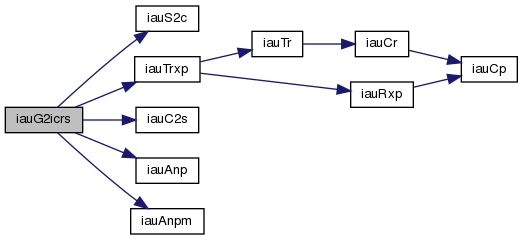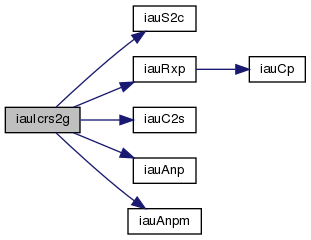Functions | |
| double | iauDtdb (double date1, double date2, double ut, double elong, double u, double v) |
| An approximation to TDB-TT. More... | |
| void | iauG2icrs (double dl, double db, double *dr, double *dd) |
| Transformation from Galactic Coordinates to ICRS. More... | |
| void | iauIcrs2g (double dr, double dd, double *dl, double *db) |
| Transformation from ICRS to Galactic Coordinates. More... | |
Detailed Description
Function Documentation
◆ iauDtdb()
| double iauDtdb | ( | double | date1, |
| double | date2, | ||
| double | ut, | ||
| double | elong, | ||
| double | u, | ||
| double | v | ||
| ) |
An approximation to TDB-TT.
An approximation to TDB-TT, the difference between barycentric dynamical time and terrestrial time, for an observer on the Earth.
The different time scales - proper, coordinate and realized - are related to each other:
TAI <- physically realized
:
offset <- observed (nominally +32.184s)
:
TT <- terrestrial time
:
rate adjustment (L_G) <- definition of TT : TCG <- time scale for GCRS : "periodic" terms <- iauDtdb is an implementation : rate adjustment (L_C) <- function of solar-system ephemeris : TCB <- time scale for BCRS : rate adjustment (-L_B) <- definition of TDB : TDB <- TCB scaled to track TT : "periodic" terms <- -iauDtdb is an approximation : TT <- terrestrial time
Adopted values for the various constants can be found in the IERS Conventions (McCarthy & Petit 2003).
- Parameters
-
[in] date1,date2 date, TDB (Notes 1-3) [in] ut universal time (UT1, fraction of one day) [in] elong longitude (east positive, radians) [in] u distance from Earth spin axis (km) [in] v distance north of equatorial plane (km)
- Returns
- TDB-TT (seconds)
Notes:
1) The date date1+date2 is a Julian Date, apportioned in any convenient way between the two arguments. For example, JD(TT)=2450123.7 could be expressed in any of these ways, among others:
date1 date2 2450123.7 0.0 (JD method) 2451545.0 -1421.3 (J2000 method) 2400000.5 50123.2 (MJD method) 2450123.5 0.2 (date & time method)
The JD method is the most natural and convenient to use in cases where the loss of several decimal digits of resolution is acceptable. The J2000 method is best matched to the way the argument is handled internally and will deliver the optimum resolution. The MJD method and the date & time methods are both good compromises between resolution and convenience.
Although the date is, formally, barycentric dynamical time (TDB), the terrestrial dynamical time (TT) can be used with no practical effect on the accuracy of the prediction.
2) TT can be regarded as a coordinate time that is realized as an offset of 32.184s from International Atomic Time, TAI. TT is a specific linear transformation of geocentric coordinate time TCG, which is the time scale for the Geocentric Celestial Reference System, GCRS.
3) TDB is a coordinate time, and is a specific linear transformation of barycentric coordinate time TCB, which is the time scale for the Barycentric Celestial Reference System, BCRS.
4) The difference TCG-TCB depends on the masses and positions of the bodies of the solar system and the velocity of the Earth. It is dominated by a rate difference, the residual being of a periodic character. The latter, which is modeled by the present function, comprises a main (annual) sinusoidal term of amplitude approximately 0.00166 seconds, plus planetary terms up to about 20 microseconds, and lunar and diurnal terms up to 2 microseconds. These effects come from the changing transverse Doppler effect and gravitational red-shift as the observer (on the Earth's surface) experiences variations in speed (with respect to the BCRS) and gravitational potential.
5) TDB can be regarded as the same as TCB but with a rate adjustment to keep it close to TT, which is convenient for many applications. The history of successive attempts to define TDB is set out in Resolution 3 adopted by the IAU General Assembly in 2006, which defines a fixed TDB(TCB) transformation that is consistent with contemporary solar-system ephemerides. Future ephemerides will imply slightly changed transformations between TCG and TCB, which could introduce a linear drift between TDB and TT; however, any such drift is unlikely to exceed 1 nanosecond per century.
6) The geocentric TDB-TT model used in the present function is that of Fairhead & Bretagnon (1990), in its full form. It was originally supplied by Fairhead (private communications with P.T.Wallace, 1990) as a Fortran subroutine. The present C function contains an adaptation of the Fairhead code. The numerical results are essentially unaffected by the changes, the differences with respect to the Fairhead & Bretagnon original being at the 1e-20 s level.
The topocentric part of the model is from Moyer (1981) and Murray (1983), with fundamental arguments adapted from Simon et al. 1994. It is an approximation to the expression ( v / c ) . ( r / c ), where v is the barycentric velocity of the Earth, r is the geocentric position of the observer and c is the speed of light.
By supplying zeroes for u and v, the topocentric part of the model can be nullified, and the function will return the Fairhead & Bretagnon result alone.
7) During the interval 1950-2050, the absolute accuracy is better than +/- 3 nanoseconds relative to time ephemerides obtained by direct numerical integrations based on the JPL DE405 solar system ephemeris.
8) It must be stressed that the present function is merely a model, and that numerical integration of solar-system ephemerides is the definitive method for predicting the relationship between TCG and TCB and hence between TT and TDB.
References:
Fairhead, L., & Bretagnon, P., Astron.Astrophys., 229, 240-247 (1990).
IAU 2006 Resolution 3.
McCarthy, D. D., Petit, G. (eds.), IERS Conventions (2003), IERS Technical Note No. 32, BKG (2004)
Moyer, T.D., Cel.Mech., 23, 33 (1981).
Murray, C.A., Vectorial Astrometry, Adam Hilger (1983).
Seidelmann, P.K. et al., Explanatory Supplement to the Astronomical Almanac, Chapter 2, University Science Books (1992).
Simon, J.L., Bretagnon, P., Chapront, J., Chapront-Touze, M., Francou, G. & Laskar, J., Astron.Astrophys., 282, 663-683 (1994).
◆ iauG2icrs()
| void iauG2icrs | ( | double | dl, |
| double | db, | ||
| double * | dr, | ||
| double * | dd | ||
| ) |
Transformation from Galactic Coordinates to ICRS.
- Parameters
-
[in] dl galactic longitude (radians) [in] db galactic latitude (radians) [out] dr ICRS right ascension (radians) [out] dd ICRS declination (radians)
Notes:
1) The IAU 1958 system of Galactic coordinates was defined with respect to the now obsolete reference system FK4 B1950.0. When interpreting the system in a modern context, several factors have to be taken into account:
. The inclusion in FK4 positions of the E-terms of aberration.
. The distortion of the FK4 proper motion system by differential Galactic rotation.
. The use of the B1950.0 equinox rather than the now-standard J2000.0.
. The frame bias between ICRS and the J2000.0 mean place system.
The Hipparcos Catalogue (Perryman & ESA 1997) provides a rotation matrix that transforms directly between ICRS and Galactic coordinates with the above factors taken into account. The matrix is derived from three angles, namely the ICRS coordinates of the Galactic pole and the longitude of the ascending node of the galactic equator on the ICRS equator. They are given in degrees to five decimal places and for canonical purposes are regarded as exact. In the Hipparcos Catalogue the matrix elements are given to 10 decimal places (about 20 microarcsec). In the present SOFA function the matrix elements have been recomputed from the canonical three angles and are given to 30 decimal places.
2) The inverse transformation is performed by the function iauIcrs2g.
Reference: Perryman M.A.C. & ESA, 1997, ESA SP-1200, The Hipparcos and Tycho catalogues. Astrometric and photometric star catalogues derived from the ESA Hipparcos Space Astrometry Mission. ESA Publications Division, Noordwijk, Netherlands.

◆ iauIcrs2g()
| void iauIcrs2g | ( | double | dr, |
| double | dd, | ||
| double * | dl, | ||
| double * | db | ||
| ) |
Transformation from ICRS to Galactic Coordinates.
- Parameters
-
[in] dr ICRS right ascension (radians) [in] dd ICRS declination (radians) [in] dl galactic longitude (radians) [in] db galactic latitude (radians)
Notes:
1) The IAU 1958 system of Galactic coordinates was defined with respect to the now obsolete reference system FK4 B1950.0. When interpreting the system in a modern context, several factors have to be taken into account:
. The inclusion in FK4 positions of the E-terms of aberration.
. The distortion of the FK4 proper motion system by differential Galactic rotation.
. The use of the B1950.0 equinox rather than the now-standard J2000.0.
. The frame bias between ICRS and the J2000.0 mean place system.
The Hipparcos Catalogue (Perryman & ESA 1997) provides a rotation matrix that transforms directly between ICRS and Galactic coordinates with the above factors taken into account. The matrix is derived from three angles, namely the ICRS coordinates of the Galactic pole and the longitude of the ascending node of the galactic equator on the ICRS equator. They are given in degrees to five decimal places and for canonical purposes are regarded as exact. In the Hipparcos Catalogue the matrix elements are given to 10 decimal places (about 20 microarcsec). In the present SOFA function the matrix elements have been recomputed from the canonical three angles and are given to 30 decimal places.
2) The inverse transformation is performed by the function iauG2icrs.
Reference: Perryman M.A.C. & ESA, 1997, ESA SP-1200, The Hipparcos and Tycho catalogues. Astrometric and photometric star catalogues derived from the ESA Hipparcos Space Astrometry Mission. ESA Publications Division, Noordwijk, Netherlands.

 1.8.16
1.8.16